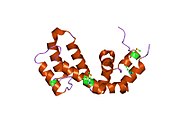RGS9
| edit |
| Regulator G-proteinske signalizacije 9 | |||||||||||
|---|---|---|---|---|---|---|---|---|---|---|---|
 PDB prikaz baziran na 1fqi. | |||||||||||
| Dostupne strukture | |||||||||||
| 1fqi, 1fqj, 1fqk | |||||||||||
| Identifikatori | |||||||||||
| Simboli | RGS9; MGC111763; MGC26458; PERRS; RGS9L | ||||||||||
| Vanjski ID | OMIM: 604067 GeneCards: RGS9 Gene | ||||||||||
| |||||||||||
| Pregled RNK izražavanja | |||||||||||
 | |||||||||||
 | |||||||||||
| podaci | |||||||||||
| Ortolozi | |||||||||||
| Vrsta | Čovek | Miš | |||||||||
| Entrez | 8787 | n/a | |||||||||
| Ensembl | ENSG00000108370 | n/a | |||||||||
| UniProt | O75916 | n/a | |||||||||
| RefSeq (mRNA) | NM_001081955 | n/a | |||||||||
| RefSeq (protein) | NP_001075424 | n/a | |||||||||
| Lokacija (UCSC) | Chr 17: 60.56 - 60.65 Mb | n/a | |||||||||
| PubMed pretraga | [1] | n/a | |||||||||
Regulator G proteinske signalizacije 9 (RGS9), je ljudski gen.[1] On kodira protein koji učestvuje u regulaciji prenosa signal unutar ćelija. Članovi RGS familije, kao što je RGS9, su signalni proteini koji sprečavaju aktivnost G proteina promovisanjem njihove deaktivacije.[1]
Postoje dve splajsne izoforme RGS9 proteina sa veoma različitim osobinama i obrascem izražavanja. RGS9-1 je uglavnom nađen u oku i učestvuje u regulaciji fototransdukcije u fotoreceptorskim ćelijama mrežnjače, dok je RGS9-2 nađen u mozgu, i reguliše dopaminsku i opioidnu signalizaciju bazalnih ganglija.[2] Iz toga proizilazi da lekovi čiji biološki cilj je RGS9 moraju da budu selektivni za specifičnu izoformu.
RGS9-2 is je od posebnog interesa kao najvažniji RGS protein u terminaciji signalizacije mi opioidnog receptora (mada RGS4 i RGS17 takođe učestvuju), i smatra se da je značajan u razvoju tolerancije za opioidne lekove.[3][4][5][6][7][8][9] RGS9-deficitarni miševi ispoljavaju određene motorne i kognitivne poteškoće, tako da je verovatno da će inhibicija ovog proteina protein izazvati slične efekte.[10]
Reference
- ↑ 1,0 1,1 „Entrez Gene: RGS9 regulator of G-protein signalling 9”.
- ↑ Martemyanov KA, Krispel CM, Lishko PV, Burns ME, Arshavsky VY (December 2008). „Functional comparison of RGS9 splice isoforms in a living cell”. Proceedings of the National Academy of Sciences of the United States of America 105 (52): 20988–93. DOI:10.1073/pnas.0808941106. PMC 2634932. PMID 19098104.
- ↑ Garzón J, Rodríguez-Díaz M, López-Fando A, Sánchez-Blázquez P (February 2001). „RGS9 proteins facilitate acute tolerance to mi-opioid effects”. The European Journal of Neuroscience 13 (4): 801–11. DOI:10.1046/j.0953-816x.2000.01444.x. PMID 11207815.
- ↑ Zachariou V, Georgescu D, Sanchez N, Rahman Z, DiLeone R, Berton O, Neve RL, Sim-Selley LJ, Selley DE, Gold SJ, Nestler EJ (November 2003). „Essential role for RGS9 in opiate action”. Proceedings of the National Academy of Sciences of the United States of America 100 (23): 13656–61. DOI:10.1073/pnas.2232594100. PMC 263869. PMID 14595021.
- ↑ Sánchez-Blázquez P, Rodríguez-Muñoz M, Montero C, Garzón J (January 2005). „RGS-Rz and RGS9-2 proteins control mu-opioid receptor desensitisation in CNS: the role of activated Galphaz subunits”. Neuropharmacology 48 (1): 134–50. DOI:10.1016/j.neuropharm.2004.08.016. PMID 15617734.
- ↑ Garzón J, Rodríguez-Muñoz M, López-Fando A, Sánchez-Blázquez P (March 2005). „Activation of mu-opioid receptors transfers control of Galpha subunits to the regulator of G-protein signaling RGS9-2: role in receptor desensitization”. The Journal of Biological Chemistry 280 (10): 8951–60. DOI:10.1074/jbc.M407005200. PMID 15632124.
- ↑ Psifogeorgou K, Papakosta P, Russo SJ, Neve RL, Kardassis D, Gold SJ, Zachariou V (October 2007). „RGS9-2 is a negative modulator of mu-opioid receptor function”. Journal of Neurochemistry 103 (2): 617–25. DOI:10.1111/j.1471-4159.2007.04812.x. PMID 17725581.
- ↑ Hooks SB, Martemyanov K, Zachariou V (January 2008). „A role of RGS proteins in drug addiction”. Biochemical Pharmacology 75 (1): 76–84. DOI:10.1016/j.bcp.2007.07.045. PMID 17880927.
- ↑ Traynor JR, Terzi D, Caldarone BJ, Zachariou V (March 2009). „RGS9-2: probing an intracellular modulator of behavior as a drug target”. Trends in Pharmacological Sciences 30 (3): 105–11. DOI:10.1016/j.tips.2008.11.006. PMID 19211160.
- ↑ Blundell J, Hoang CV, Potts B, Gold SJ, Powell CM (January 2008). „Motor coordination deficits in mice lacking RGS9”. Brain Research 1190: 78–85. DOI:10.1016/j.brainres.2007.11.017. PMC 2241663. PMID 18073128.
Literatura
- Bonaldo MF, Lennon G, Soares MB (1997). „Normalization and subtraction: two approaches to facilitate gene discovery.”. Genome Res. 6 (9): 791–806. DOI:10.1101/gr.6.9.791. PMID 8889548.
- Cowan CW, Fariss RN, Sokal I, et al. (1998). „High expression levels in cones of RGS9, the predominant GTPase accelerating protein of rods.”. Proc. Natl. Acad. Sci. U.S.A. 95 (9): 5351–6. DOI:10.1073/pnas.95.9.5351. PMC 20264. PMID 9560279.
- Granneman JG, Zhai Y, Zhu Z, et al. (1998). „Molecular characterization of human and rat RGS 9L, a novel splice variant enriched in dopamine target regions, and chromosomal localization of the RGS 9 gene.”. Mol. Pharmacol. 54 (4): 687–94. PMID 9765512.
- Zhang K, Howes KA, He W, et al. (2000). „Structure, alternative splicing, and expression of the human RGS9 gene.”. Gene 240 (1): 23–34. DOI:10.1016/S0378-1119(99)00393-5. PMID 10564809.
- Yu H, Bondarenko VA, Yamazaki A (2001). „Inhibition of retinal guanylyl cyclase by the RGS9-1 N-terminus.”. Biochem. Biophys. Res. Commun. 286 (1): 12–9. DOI:10.1006/bbrc.2001.5346. PMID 11485301.
- Hu G, Wensel TG (2002). „R9AP, a membrane anchor for the photoreceptor GTPase accelerating protein, RGS9-1.”. Proc. Natl. Acad. Sci. U.S.A. 99 (15): 9755–60. DOI:10.1073/pnas.152094799. PMC 125004. PMID 12119397.
- Strausberg RL, Feingold EA, Grouse LH, et al. (2003). „Generation and initial analysis of more than 15,000 full-length human and mouse cDNA sequences.”. Proc. Natl. Acad. Sci. U.S.A. 99 (26): 16899–903. DOI:10.1073/pnas.242603899. PMC 139241. PMID 12477932.
- Martemyanov KA, Lishko PV, Calero N, et al. (2003). „The DEP domain determines subcellular targeting of the GTPase activating protein RGS9 in vivo.”. J. Neurosci. 23 (32): 10175–81. PMID 14614075.
- Nishiguchi KM, Sandberg MA, Kooijman AC, et al. (2004). „Defects in RGS9 or its anchor protein R9AP in patients with slow photoreceptor deactivation.”. Nature 427 (6969): 75–8. DOI:10.1038/nature02170. PMID 14702087.
- Ajit SK, Young KH (2004). „Enhancement of pheromone response by RGS9 and Gbeta5 in yeast.”. Biochem. Biophys. Res. Commun. 324 (2): 686–91. DOI:10.1016/j.bbrc.2004.09.100. PMID 15474482.
- Cheng JY, Luu CD, Yong VH, et al. (2007). „Bradyopsia in an Asian man.”. Arch. Ophthalmol. 125 (8): 1138–40. DOI:10.1001/archopht.125.8.1138. PMID 17698770.
- p
- r
- u
Monomerni | |
|---|---|
Heterotrimeni |











